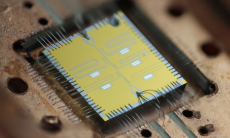Record-breaking 45-qubit Quantum Computing Simulation Run at NERSC on Cori
June 1, 2017
By Kathy Kincade
Contact: cscomms@lbl.org

A multi-qubit chip developed in the Quantum Nanoelectronics Laboratory at Lawrence Berkeley National Laboratory.
When two researchers from the Swiss Federal Institute of Technology (ETH Zurich) announced in April that they had successfully simulated a 45-qubit quantum circuit, the science community took notice: it was the largest ever simulation of a quantum computer, and another step closer to simulating “quantum supremacy”—the point at which quantum computers become more powerful than ordinary computers.
The computations were performed at the National Energy Research Scientific Computing Center (NERSC), a DOE Office of Science User Facility at the U.S. Department of Energy’s Lawrence Berkeley National Laboratory. Researchers Thomas Häner and Damien Steiger, both Ph.D. students at ETH, used 8,192 of 9,688 Intel Xeon Phi processors on NERSC’s newest supercomputer, Cori, to support this simulation, the largest in a series they ran at NERSC for the project.
“Quantum computing” has been the subject of dedicated research for decades, and with good reason: quantum computers have the potential to break common cryptography techniques and simulate quantum systems in a fraction of the time it would take on current “classical” computers. They do this by leveraging the quantum states of particles to store information in qubits (quantum bits), a unit of quantum information akin to a regular bit in classical computing. Better yet, qubits have a secret power: they can perform more than one calculation at a time. One qubit can perform two calculations in a quantum superposition, two can perform four, three eight, and so forth, with a corresponding exponential increase in quantum parallelism. Yet harnessing this quantum parallelism is difficult, as observing the quantum state causes the system to collapse to just one answer.
So how close are we to realizing a true working prototype? It is generally thought that a quantum computer deploying 49 qubits—a unit of quantum information—will be able to match the computing power of today’s most powerful supercomputers. Toward this end, Häner and Steiger’s simulations will aid in benchmarking and calibrating near-term quantum computers by carrying out quantum supremacy experiments with these early devices and comparing them to their simulation results. In the mean time, we are seeing a surge in investments in quantum computing technology from the likes of Google, IBM and other leading tech companies—even Volkswagen—which could dramatically accelerate the development process.
Simulation and Emulation of Quantum Computers
Both emulation and simulation are important for calibrating, validating and benchmarking emerging quantum computing hardware and architectures. In a paper presented at SC16, Häner and Steiger wrote: “While large-scale quantum computers are not yet available, their performance can be inferred using quantum compilation frameworks and estimates of potential hardware specifications. However, without testing and debugging quantum programs on small scale problems, their correctness cannot be taken for granted. Simulators and emulators … are essential to address this need.”
That paper discussed emulating quantum circuits—a common representation of quantum programs—while the 45-qubit paper focuses on simulating quantum circuits. Emulation is only possible for certain types of quantum subroutines, while the simulation of quantum circuits is a general method that also allows the inclusion of the effects of noise. Such simulations can be very challenging even on today’s fastest supercomputers, Häner and Steiger explained. For the 45-qubit simulation, for example, they used most of the available memory on each of the 8,192 nodes. “This increases the probability of node failure significantly, and we could not expect to run on the full system for more than an hour without failure,” they said. “We thus had to reduce time-to-solution at all scales (node-level as well as cluster-level) to achieve this simulation.”
Optimizing the quantum circuit simulator was key. Häner and Steiger employed automatic code generation, optimized the compute kernels and applied a scheduling algorithm to the quantum supremacy circuits, thus reducing the required node-to-node communication. During the optimization process they worked with NERSC staff and used Berkeley Lab’s Roofline Model to identify potential areas where performance could be boosted.
In addition to the 45-qubit simulation, which used 0.5 petabytes of memory on Cori and achieved a performance of 0.428 petaflops, they also simulated 30-, 36- and 42-qubit quantum circuits. When they compared the results with simulations of 30- and 36-qubit circuits run on NERSC’s Edison system, they found that the Edison simulations also ran faster.
“Our optimizations improved the performance – the number of floating-point operations per time – by 10x for Edison and between 10x and 20x for Cori (depending on the circuit to simulate and the size per node),” Häner and Steiger said. “The time-to-solution decreased by over 12x when compared to the times of a similar simulation reported in a recent paper on quantum supremacy by Boixo and collaborators, which made the 45-qubit simulation possible.”
Looking ahead, the duo is interested in performing more quantum circuit simulations at NERSC to determine the performance of near-term quantum computers solving quantum chemistry problems. They are also hoping to use solid-state drives to store larger wave functions and thus try to simulate even more qubits.
About NERSC and Berkeley Lab
The National Energy Research Scientific Computing Center (NERSC) is a U.S. Department of Energy Office of Science User Facility that serves as the primary high performance computing center for scientific research sponsored by the Office of Science. Located at Lawrence Berkeley National Laboratory, NERSC serves almost 10,000 scientists at national laboratories and universities researching a wide range of problems in climate, fusion energy, materials science, physics, chemistry, computational biology, and other disciplines. Berkeley Lab is a DOE national laboratory located in Berkeley, California. It conducts unclassified scientific research and is managed by the University of California for the U.S. Department of Energy. »Learn more about computing sciences at Berkeley Lab.







